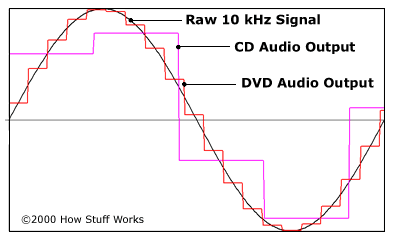
For most people the word "turntable" brings to mind the scratchy
sound of the ancient record players popular in the 1950's. If you think the
turntable is nothing but an out-dated and obsolete sound reproduction device,
then you are mistaken. Believe it or not, the best quality sound does not come
from a CD or even a DVD but from good old fashioned vinyl. Surprised? You shouldn't
be. A vinyl record is recorded in analog format. Sound waves through the air,
recorded in analog format, are transcribed directly into identical waves on
a different medium (vinyl, oxide tape, steel). Because the entire wave is copied,
the recorded sound is nearly identical to the sound in the air. CDs and DVDs
record in digital format; they take samples of the wave at different times (44,100
times/second for a tape) and convert the general shape of the wave into numbers.
As you can see in the graph below, neither CDs of DVDs are able to match the
sound wave perfectly.
Comparison of a raw analog audio signal to the CD audio and DVD audio output
Home The Turntable The Stylus The Vinyl Dr. Physics Bibliography